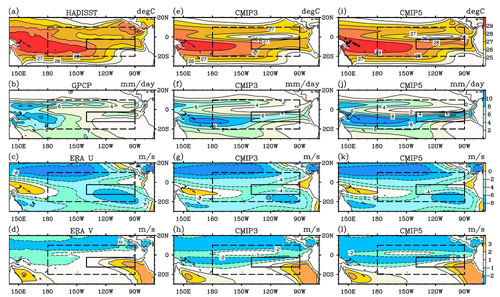
Coupled ocean-atmospheric climate models tend to simulate a double Intertropical Convergence Zone (ITCZ) that is characterized by two zonal bands of annual precipitation in the equatorial central Pacific that is not present in observations. The spurious double ITCZ not only creates the simulation biases of tropical climate variability such as the well known El Nino-Southern Oscillation(ENSO) and Madden Julian Oscillation(MJO) but also impacts the global energy balance and mid-latitude climate, severely limiting the ability of climate simulation and prediction.
Previous studies often focus on individual models at different stages of their developments, a recent work from the Institute of Atmospheric Physics of Chinese Academy of Sciences (IAP/CAS) evaluated the collective progress of coupled climate models in reducing the double ITCZ bias from the time of Coupled Model Intercomparison Project Phase 3 (CMIP3) to Phase 5 (CMIP5).
Based on multi-model ensembles of historical climate simulations, the performances of the CMIP3 and CMIP5 models in simulating SST, precipitation, and surface winds in the equatorial pacific are examined to see whether the overall performances of the CMIP5 models are better than that of CMIP3.
The study of ZHANG Xiaoxiao, LIU Hailong, and ZHANG Minghua showed that the biases described for CMIP3 models continue to be obvious problems in CMIP5 models: spurious precipitation maximum in the southeastern Pacific, warmer sea surface temperature (SST), weaker easterly, and stronger meridional wind divergences away from the equator relative to observations. It is found that there is virtually no improvement from the CMIP3 ensemble to the CMIP5 ensemble models. SST (Figures 1a and 1b) in CMIP5 is overall warmer than in CMIP3, leading to a greater double ITCZ bias in precipitation (Figures 1c and 1d) than in CMIP3 models.
The five best performing models in the two ensembles as measured by the spatial correlations are also assessed. No progress can be identified in the top models from CMIP3 to CMIP5 even though more models participated in CMIP5. The biases of excessive precipitation and overestimated SST in southeastern Pacific are in fact even worse in the CMIP5 models.

Figure 1. (a) Sea surface temperature from HadISST during 1979–2005 (°C), (b) precipitation from GPCP during 1979–2005 (mm/d), (c) zonal, and (d) meridional wind at 10m from ERA-40 during 1979–2005 (m/s) for March. (e–l) Same as Figures 1a–1d but for multi-model ensemble means for CMIP3 and CMIP5, respectively. (Zhang et al., 2015)
Unfortunately, although many modeling groups have upgraded their models significantly, there is no evidence of improvements in both the total ensembles and the sub-ensembles of the five best models of the CMIP5 models compared with CMIP3 models on this long-standing issue. It is hoped that the results from this work will lead to more attentions to the double ITCZ problem that will motivate future research to eliminate this bias.
This study is recently accepted by Geophysical Research Letters.
Reference: Xiaoxiao Zhang, Hailong Liu, Minghua Zhang, 2015: Double ITCZ in Coupled Ocean-Atmosphere Models: From CMIP3 to CMIP5,Geophys. Res. Lett., DOI: 10.1002/2015GL065973

86-10-68597521 (day)
86-10-68597289 (night)

52 Sanlihe Rd., Xicheng District,
Beijing, China (100864)

